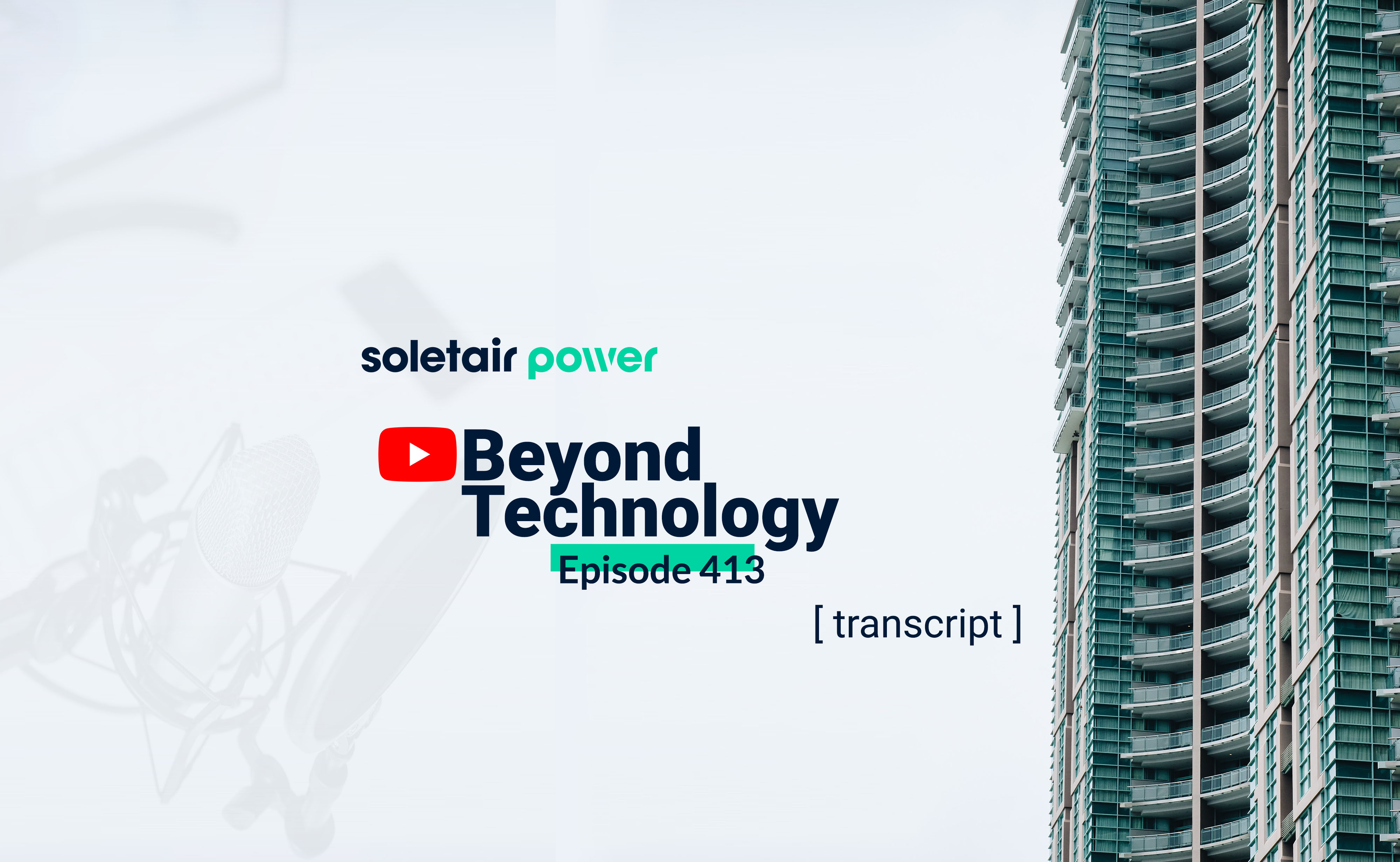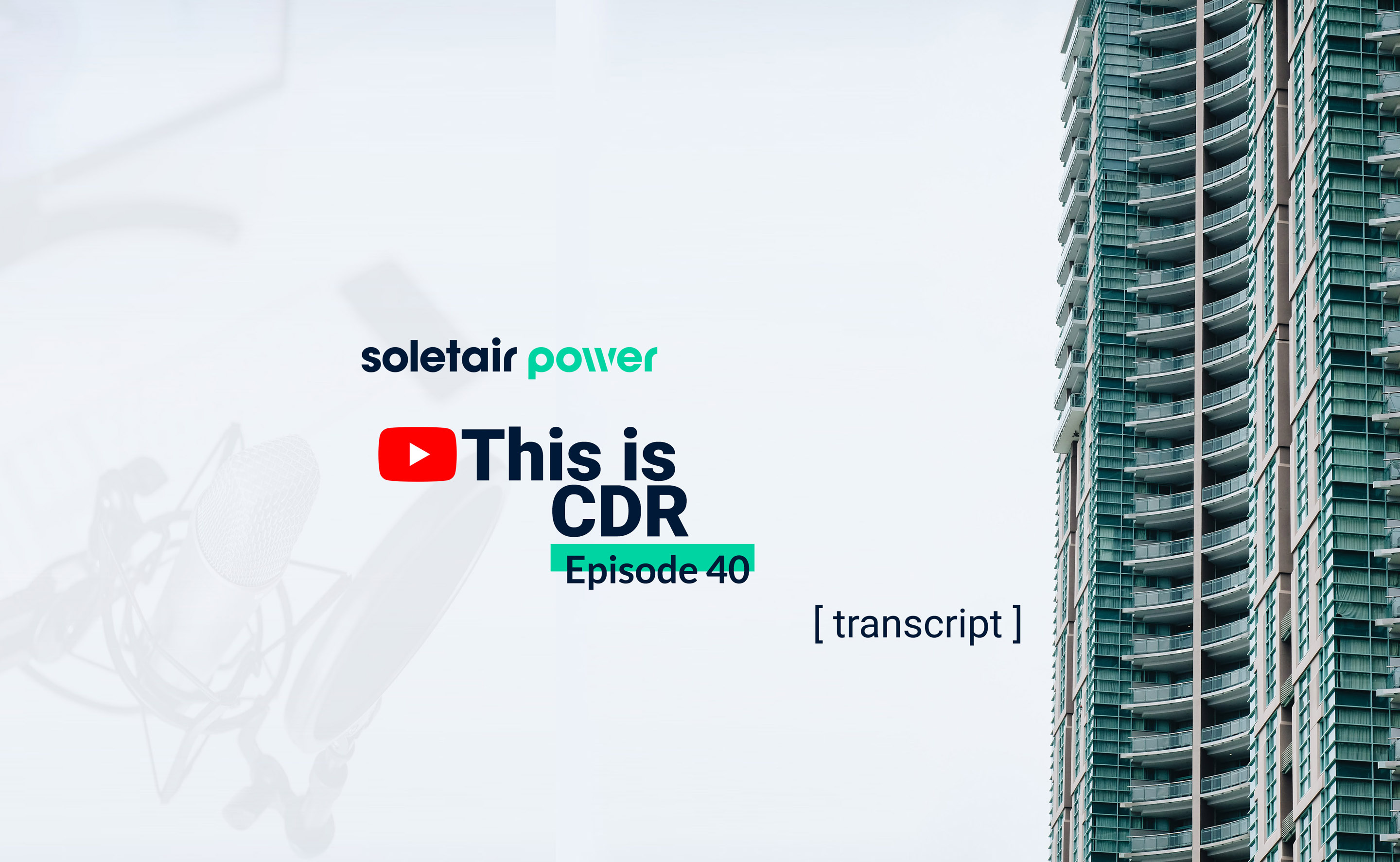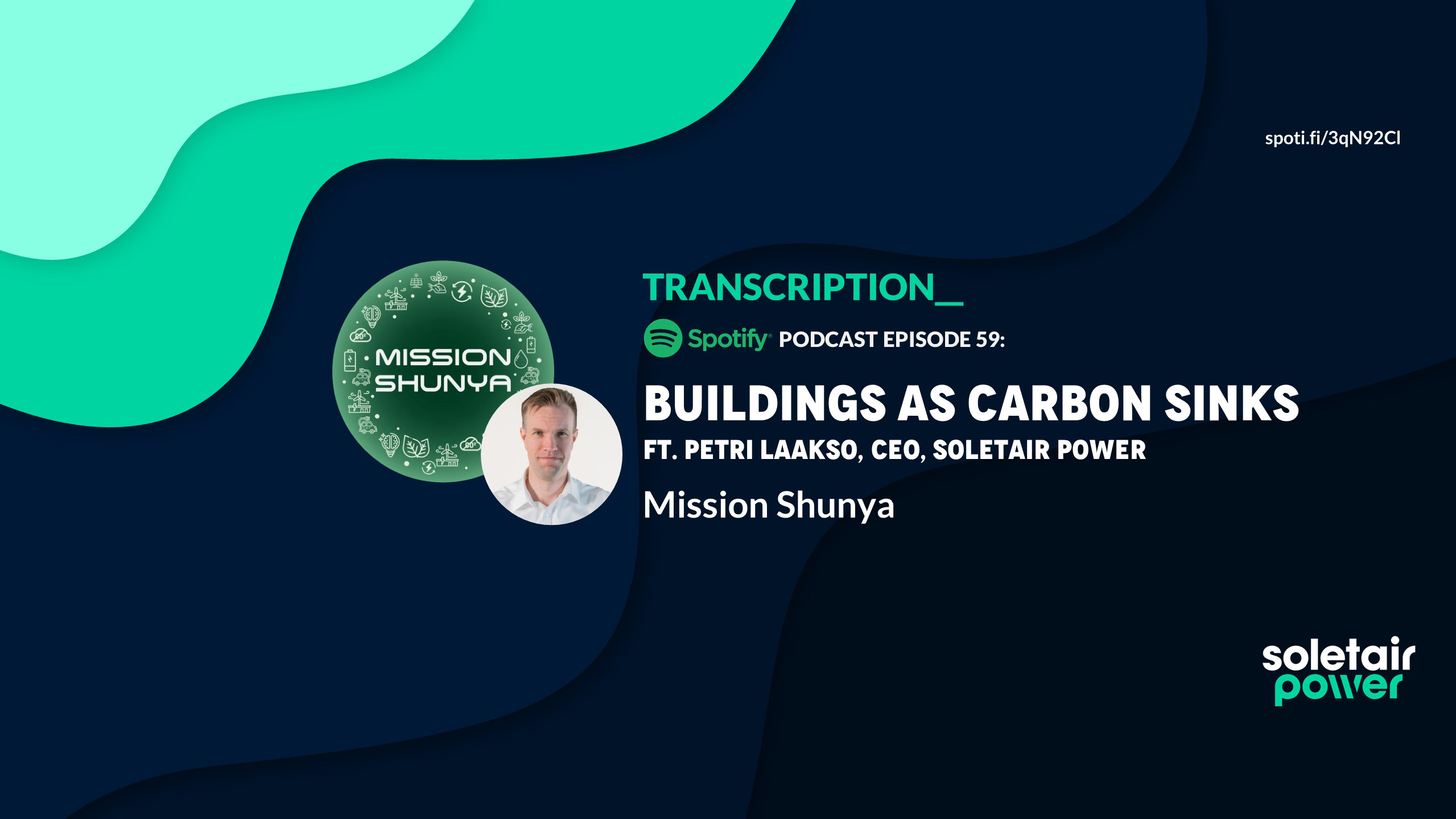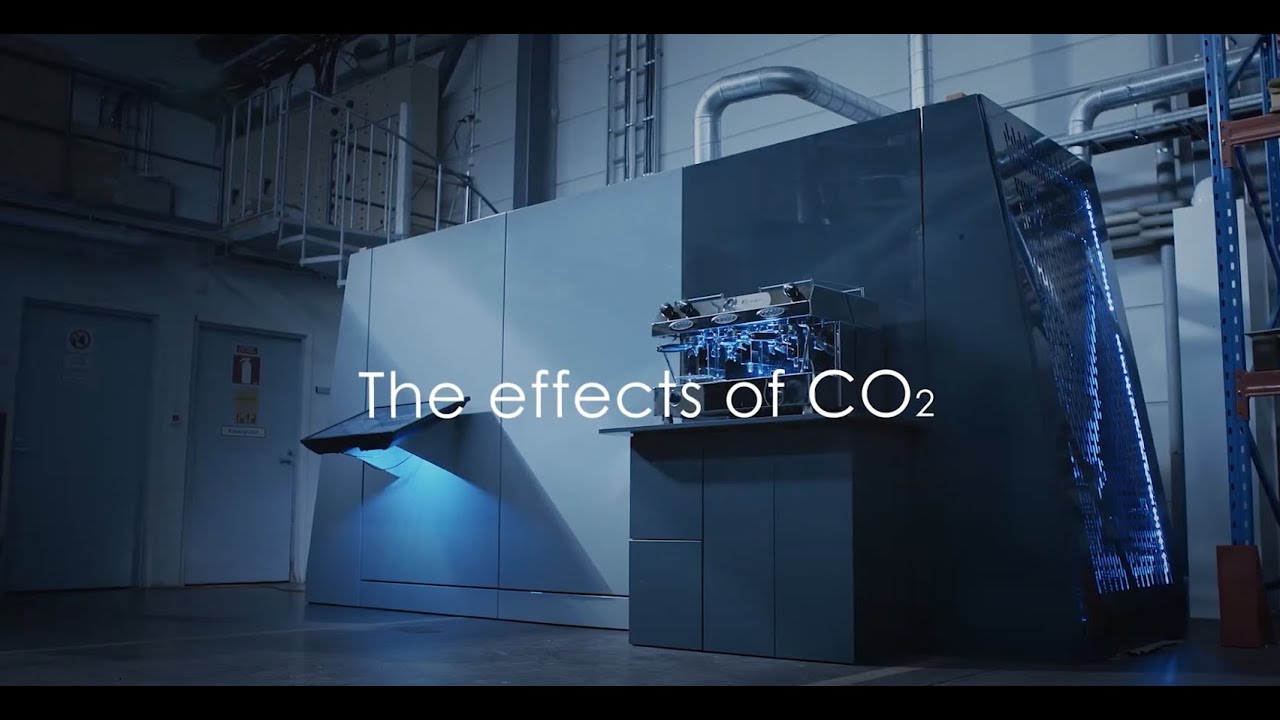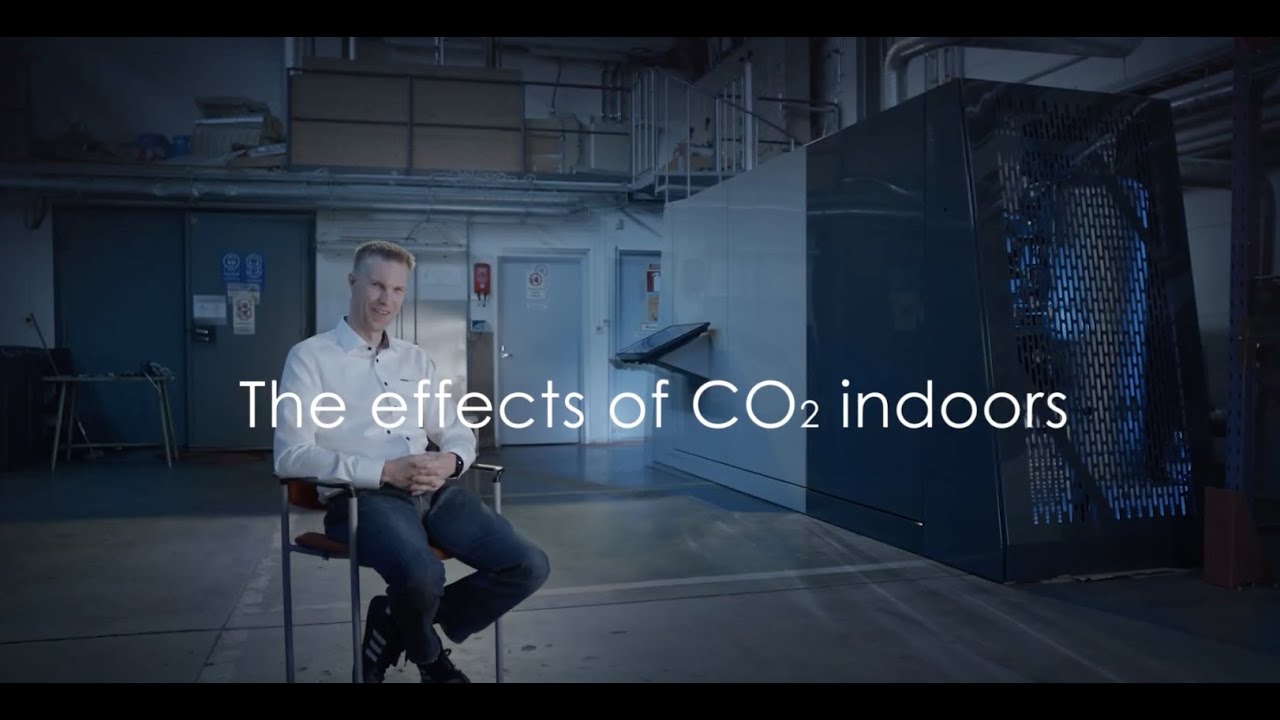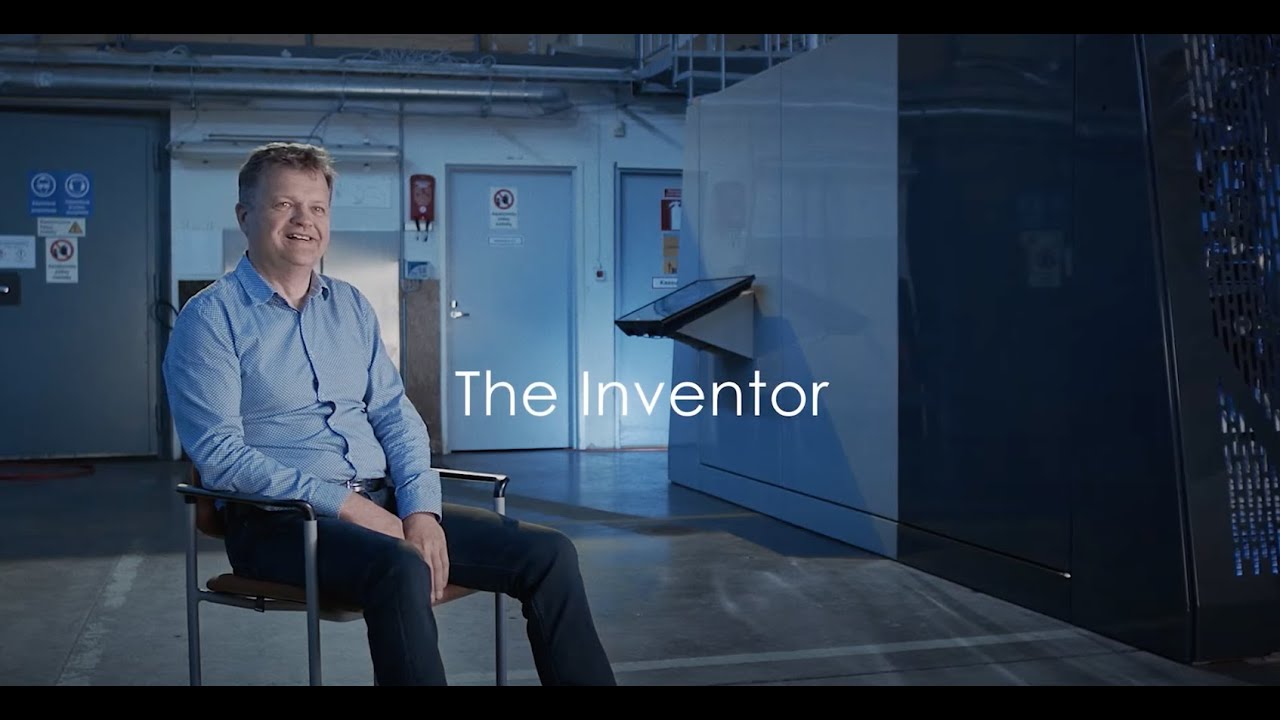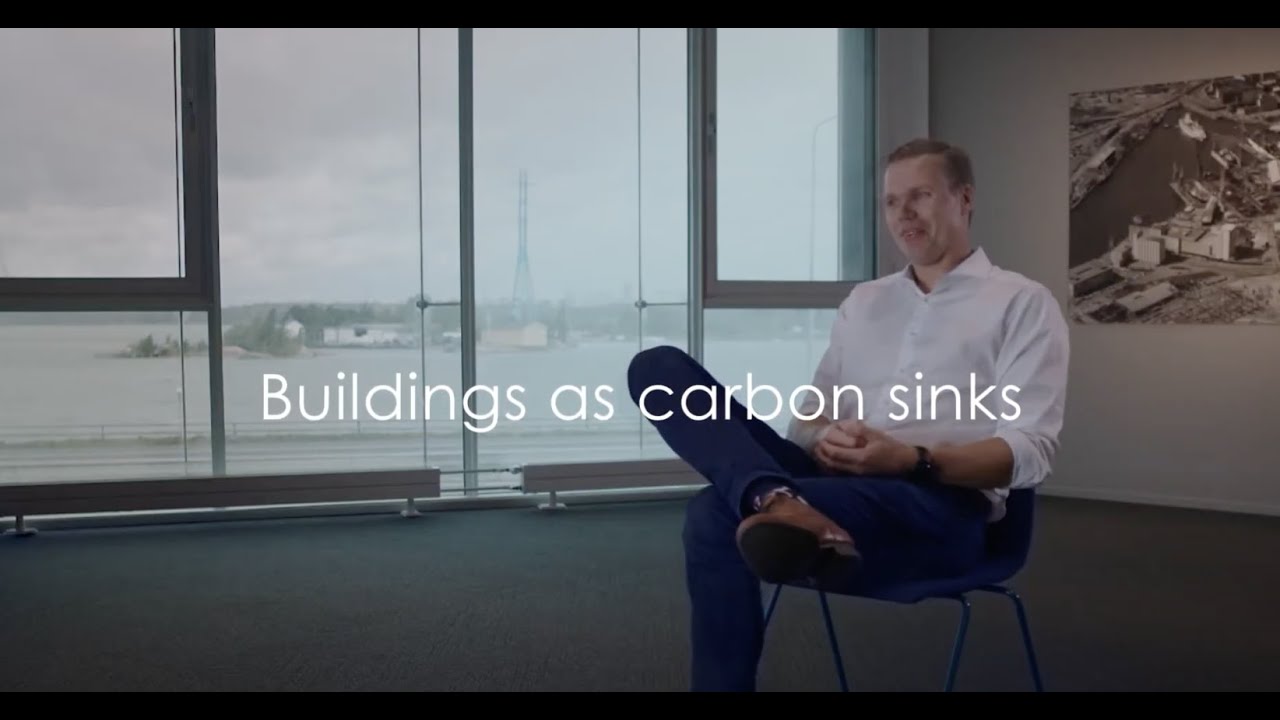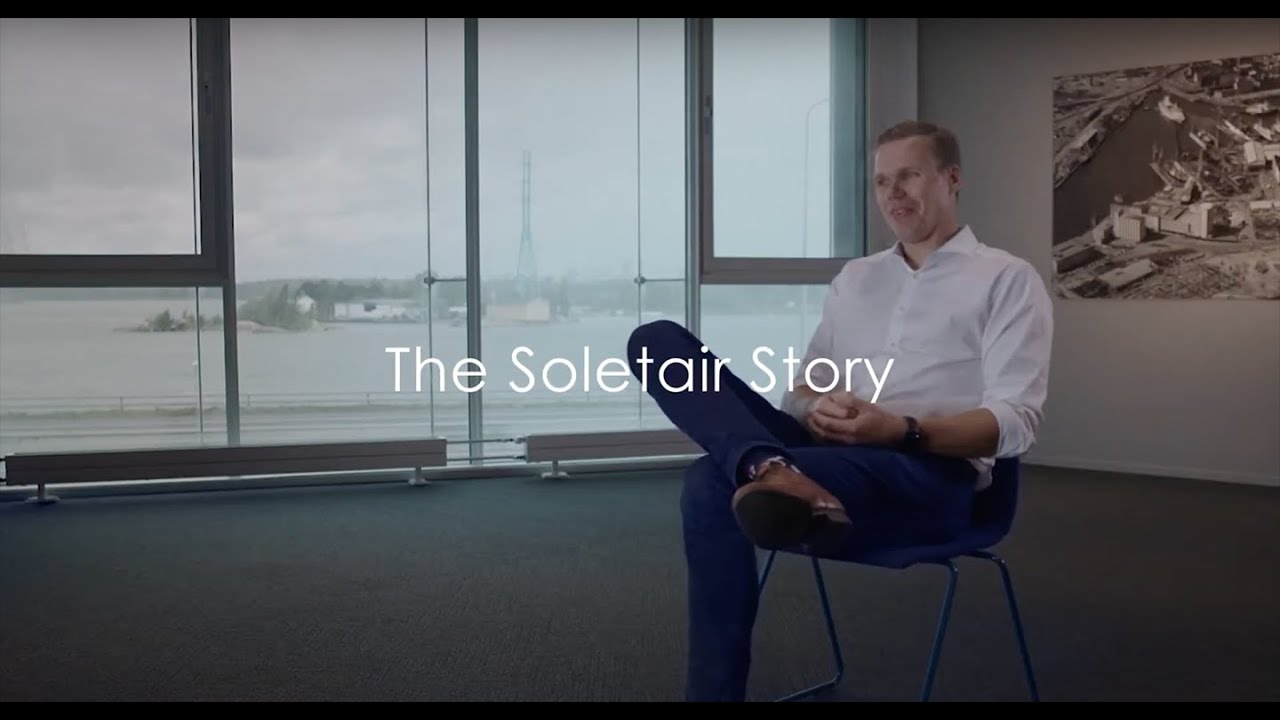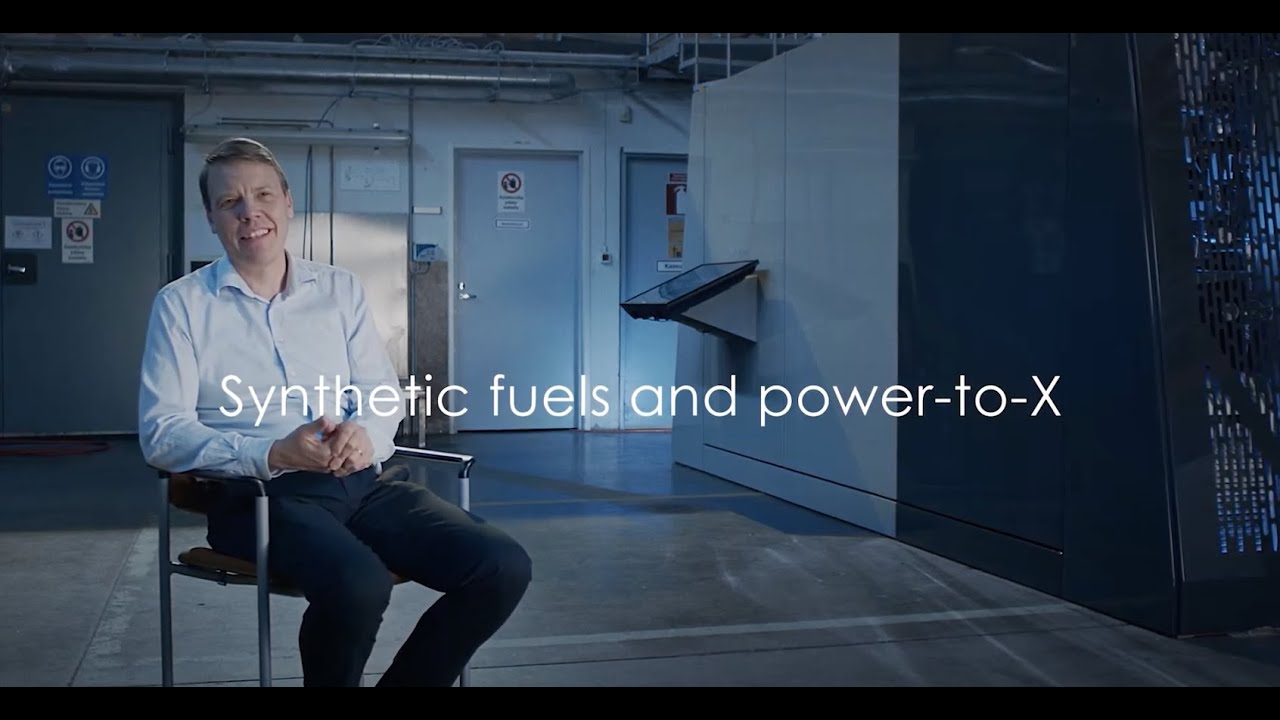Watch Episode 413 of Beyond Technology about Soletair Power’s enabling CO2 capture in buildings below:
Transcript of the Podcast:
If you look at buildings on a global level — they are resulting in like 38 percent of global CO2 emissions. As we say — we can make buildings as carbon sinks — that could be a really big thing if we could deploy our technology in each and every building in the world. That is how we see that we can make a big difference.
[Music]
Hi Petri, I’m very happy that you’re here. Carbon capture is your business, your work, which is a lot focused on impact and sustainability and I’m really curious to learn more about your journey, also about your outcome or impact more in detail. So, thanks for taking the time, and let’s talk about your purpose.
Yeah, thanks for the invitation, nice to be here today.
So, you do what you do today for a specific reason, I guess, you aren’t there by chance. So how did everything start for you? Why is carbon capture and having an impact a relevant thing for you personally?
Prior to this job I was working in a company that was making photovoltaics, solar panels, solar cells, installations with solar panels, and also big projects there. And I knew the founders of this company, and the founders called me and asked whether I would like to join. I saw that this is an even better kind of way to affect climate change than the previous job. Even solar is a really big thing in the world, a good way and cheap way to do electricity. But carbon capture can really contribute to this, of course, I wanted to be the captain of the ship – running the company as a CEO. So that is why I’m here today and now we are getting pretty nice progress with all the projects that we’ve done. So, we really see that we can change things in the world.
How has it been? How has climate change and addressing and maybe contributing to solving this problem, this crisis, how has this become a thing for you personally in your life?
Of course, it’s something that I have told others that we should kind of keep nature as it is. Of course, we are only a small piece in the puzzle to solve it, but we want to be part of that and I think all the people in the company are kind of true believers that we can make a change. But it will take time for sure. It’s not ready yet, but we do our share.
When you have a look at your work and the outcome of your work in your organization, how would you describe that? How would you describe the traction you’re seeing right now? How much can you really contribute right now? And what more, maybe also from the environment, from the whole ecosystem, what should be or how much more change do you need to really be effective?
Well, we do direct air capture in a bit different way than what others are doing. For example, we focus partly on the buildings. If you look at buildings on a global level — they are resulting in like 38 percent of global CO2 emissions. As we say — we can make buildings as carbon sinks — that could be a really big thing if we could deploy our technology in each and every building in the world. That is how we see that we can make a big difference. Of course, we can do outdoor capture with the same technology, but by capturing CO2 from building ventilation, we see that we can make a big change.
Can you maybe share a little bit in detail about how it works on a technical level and what you do?
Yeah, it’s a solid sorbent I mean functionalized. So, that, and then the temperature swing adsorption process with the vacuum step also, because without the vacuum you cannot get pure CO2. For example, the unit that we are now building for a German customer, or are just about to send it there, is creating 99.9 percent pure CO2, the rest is humidity. So first we just push air through the system, and the CO2 is absorbed on the sorbent. Then when it saturates, we close down the direct air capture air contactor and make a vacuum step. Then we start heating up the sorbent and the solvent starts releasing CO2. We then use another vacuum pump to take out the CO2 in pure form. It has of course humidity in it, so we need to remove the humidity. Then we have a compressor that compresses the CO2 into the buffer tank. So that’s like a short explanation.
Two questions. Maybe a super easy-to-understand, grammar-ready level. First: where does this CO2 come from? How is it created in the buildings? Second question: the CO2 that you have extracted from this through this process, where does this CO2 go to?
Maybe first about where the CO2 comes from. Well, we operate in the building ventilation on the inlet side. So, basically, it’s outdoor air that we capture the CO2 from. And why we do it in buildings is because the CO2 capture cost per ton is currently so high, that just by selling that CO2, you cannot be profitable. If we do it in buildings, we can sell the indoor air as a service, plus the CO2 — so this way we can be profitable. We can also do the exhaust side of a building. Then we can also capture the CO2 exhaled by the people. This is what we are going to do for our next customer. They wanted to do that when they exhale in an office. They can say that they utilize that CO2 in their own manufacturing process a bit later when the CO2 is captured. And we can also do this recirculated air within the building in countries where you have a lot of air cooling, you recirculate a lot of air, so we can also capture the CO2 from that. But the main idea, in the beginning, was that we capture it from the inlet side. And then what was the second part of your question?
Yeah. First, I think it’s super fascinating and I haven’t thought that we are also part of the problem, as people, just by existing and by breathing. But that makes a lot of sense, and the second part of the question was, if you extract that or when you extract that CO2, where does the pure CO2 go to?
There are our current customers. They are all utilizing the CO2 that they get out of the system. For example, you can make fuels. That’s what we did at Dubai World Expo. So, we captured CO2 from the expo building, actually completely indoor air, and then we utilized the electrolyzer to create hydrogen then we had a synthesis module and we synthesized synthetic natural gas which we utilized in a coffee machine to heat up the water. So that was a demonstration of Power-to-X. That is one utilization case.
In the case that we are now doing for Germans, they will utilize the pressurized 50 bar CO2 in their own fuel production process. The next customer will utilize the pressurized CO2 for their own production, so they will utilize it. Of course, if you want to make negative emissions, you need to permanently sequestrate the CO2, so then, for example, utilizing a process that captures the CO2. There are startups in the world that utilize CO2 in concrete manufacturing. So, you kind of turn the CO2 into calcium carbonate in the concrete manufacturing process, and then, it’s a permanent kind of sequestration of CO2. If you have a natural gas line connected to the building, you can create gas in the building, and inject that gas into the pipeline, so you don’t need to transport the fuel away. So, you can utilize the CO2 over and over again, and capture it again after you have utilized it, or then you can do permanent sequestration. And of course, you can put the CO2 underground also, if you want to do that, but I’m not a believer myself. What happens if there’s an earthquake? Will the CO2 come back again?
I think it’s incredibly fascinating actually how many solutions are out there, like first addressing the problem of how to extract the CO2 of the environment we see right now, and then how to make use of that even maybe do it even like a circular thing. It is extremely, extremely, impressive and it definitely has to do something with the pressure that we see right now. Maybe the last 10 years or even 20 years that more and more companies now think about how to resolve that problem. What is your observation when it comes to these technologies that we see right now to solve this problem? When did they start that? We see so many of them at that scale, or so many interesting approaches, maybe not all of them are like proven concepts, but what’s your observation when did it start that the sector is really really putting attention to this through solving the problem? Has it been like five years, ten years, and what was the reason for that development?
I think the overall situation with climate change is putting people to think about different solutions. Over the last two years, there have been several direct air capture companies founded and not all of them have any working equipment yet. But they are coming, and they have different kinds of ideas, different technologies than what we are utilizing. And of course, there are some companies that have been on the market for 10 years already. They have been the early movers and fighting the windmills.
When we started, end of 2018, oh when I joined the company in Spring 2019, when we spoke to people, some people were like – “Don’t do that! It’s completely stupid.” But now the wind has changed a bit. Nowadays even those people are saying that yeah that is the way to go and please do what you’re doing. But I can imagine, 10 years ago, saying that we are going to capture CO2 from the air, even though it works, they must have claimed people stupid that why are you doing something like that. So, I think within the last two years, we’ve seen a lot of developments and in the next five to ten years, I think this will be a technology that can be really utilized on a larger scale and in a cost-efficient manner.
We have a lot of hope in technology definitely to solve this. Humanity somehow managed to overcome the biggest challenges through technologies or through political change and definitely there is a bet on tech. I was at a climate summit one week ago actually, where they were talking about sequestration, for example, and different ways of doing this, and it was like your case – super fascinating. One aspect of a cycle and ecosystem of how to deal with CO2. And it’s really interesting, it gives hope that there will be a solution or maybe like a thousand solutions working together collaboratively on this thing and can make a huge difference. And maybe at some point, someone has a breakthrough technology to even leapfrog to an end solution to this. I’m super impressed by that. We also have to have in mind that people have to change, and for that, we need common sense on this. I guess we see a lot of frameworks from the regulatory side of politics that try to address that and make us aware of this as people but also companies and states, even countries. One of the frameworks I’m always referring to is the ESG Sustainable Development Goals of the United Nations. How important are those frameworks for your work and what’s your observation of their impact on like the overall movement when it comes to solving the climate crisis?
Of course, it’s good that somebody makes that kind of a roadmap and things which you should kind of contribute into. We kind of contribute to the three SDG activities – number 3, 11, and 13. So, Good health and well-being (SDG 3) through the one that we capture the CO2 away and we can make better indoor air for people. And of course, Stopping climate change (SDG 13), and Sustainable cities and communities (SDG 11) through that we make those negative emissions in buildings. If we can make buildings carbon sinks, it’s going to make a minus 40 percent in the global CO2 emissions, and climate action of course is there. So, I think it’s really good to have these kinds of things and we want to be part of that.
Do you think that we see the effect of those frameworks of the SDGs when you see other companies, maybe outside of your specific industry? Do you think we see enough traction to really put those frameworks and those aspects into action?
Well. Many companies are doing that and for example, in the direct air capture business, there are several well-known companies that are putting money already into the voluntary CO2 credit market. So, it’s really good that there are that kind of companies that actually contribute to this and make kind of development of technology through their actions. When you have a roadmap then everybody has a goal to follow. If you don’t have a goal, then you don’t know where to go. It’s important in a startup that we have a goal to direct where you need to go and then you know that.
Maybe it’s interesting also from your perspective when we have a look at the capital side. So, startups and young companies try to address those things and want to be part of the positive change. And of course, there’s, at some point, always money needed to do the next step. For example, in your case, a hardware-heavy organization always needs at some point backing to do the next step. What’s your observation of the venture capital scene on the capital side when it comes to this? Are they also addressing this? Are they interested in putting money into those kinds of solutions? The reason I’m asking this is, that I still have the observation that a lot of money still goes into when it comes to metrics like almost 100 percent is focused on profitability no matter. It shouldn’t be harmful, right? But apart from that, it’s more focused on users and then customers rather than a goal that is more or less focused on society at large what’s your observation when it comes to the capital side?
We are fundraising at the moment. I’ve been talking to several investors. There are investors who are really interested in ESG and if you are doing something that is not aligned with their mentality then they will not invest even though it would be a really remarkable idea or a company. But then there are of course those companies also that don’t mind about the ESG. They just care about money. But I think, the majority of the investors, want to be involved in climate change and want to do good things and many of the investors are also asking about those SDGs that in which SDGs are you contributing. So, I think it’s a good thing. Overall if you look at the stock market, if the ESG values are true in a company, I think it’s making better money for the share owners for example. So, well, I don’t want to name any companies. There are companies that when they think about these things, overall, the company is in good shape also and the consumers and other companies like those companies.
Yeah, it’s good to see that, I mean, that you have the unique perspective on this because you are at the forefront of working on that problem, and you’re raising money and so on. So you have the best insight into the actual scene and what’s going on. Yeah, I have a slightly different view on this. But I’m hoping that what you’re saying is right and we see more and more money flowing towards those goals, let’s say, I mean solving problems on that on that level and see how we can make a profitable business out of that situation. So, I think a very good thing, and I hope that more and more capital companies or capital firms follow along.
Maybe the investors that I’ve been talking to are the groups that are interested about ESG. So it could be that the ones that want to have quick profits are not talking to us at all, at the moment.
They just have a quick look on your website, and they say I mean I think we talked before like B2B hardware is really like such a turn-off for so many investors. Well, but enough investor-bashing. I hope that you find a good partner in this and someone who believes in that. That’s very important to have a strategic partner, a sparring partner in a few different things, maybe also on a strategic level and goal setting and stuff like that. And I think they can really be of much help and value here. I’d like to ask you one question that almost is my favorite one which is about your company. How this is set up? How is this built? What is its identity? What’s your philosophy or however you want to call it. I picked up a phrase for that, which is “the heart and soul” of an organization, “the heart and soul” of a company, how would you describe the heart and soul of your company?
Well, it’s about the people and I think people are making the heart and soul of the company. They are the most important ones. Without the people, we don’t have a company. We have really good people contributing to what we are doing, and we are like doing teamwork. We’ve been lucky to hire good people because it’s not that easy to find them. And we want to be fair, and, in a startup, we can be a little bit like not so corporate style kind of thing, that if somebody needs to go somewhere, they are free to do so, yeah as they just do the things that they are expected to do. So, it’s a little bit relaxed. And I want that everybody in the company is feeling good and wants to do the things and they have the freedom to do the things that they want to do. So, then it’s going to be the best possible output for the company.
It could be that sometimes we are doing wrong things, but that’s learning, and that is what we need to do, and we don’t want to limit people too much. We want to have different kinds of people working we don’t want to have 10 mechanical engineers, that’s not going to yield anything good. Everybody is nodding that “Yeah, this is a good way to go”, and we run into a wall or something, but when we have different people from chemistry, electrical engineering, mechanical engineering, the outcome will be the best one possible.
I really like the answer as always when it comes to people first – is always for me a very very good answer. That’s something I picked up also a couple of years ago. You need to focus on your people and if they are happy, they will do a good job, a good work, and then you have happy customers follow along. If everything works, then you as a founder or a part of the founder team will be happy as well. I think that’s the right order, really. And you mentioned how this could work in detail; a bit more freedom but also more trust of course, so that they do their work. How did you and the founder team come up with a structure like that? How has this become a company with people in focus and giving them some space so they can perform and really grow? How has this become a relevant thing for you and your co-founders?
I think it’s been always in my career that I believe in people, and the people are the ones that are doing the profit for the company. Without those people and their genius minds, it’s impossible to make anything happen. If I would be the one guy saying all the answers, I think we would not be this far. I would like to be surrounded by smarter people than me, and that’s what has happened. So that they can tell me what they are doing and contribute to the agenda that what we are doing. So that’s the mentality that we have in this company that people can do, not what they want to do, but let’s say contribute to the agenda, and this way we are the best team possible, and they want to be in the company also. Because that is something. If people leave, a lot of know-how goes away. That’s also something that we need to be careful of so that people are happy at their jobs.
I can definitely imagine that this is a really tricky thing because you are in a very specific area and gaining knowledge in this, acquiring knowledge in this area is super crucial and keeping it and maintaining it is even more so. Yeah, also from a technical perspective, as you showed it before, is super fascinating for me. Maybe you can share how you in your company and with your team plan to develop further, like your products further along. How does innovation work in your organization? Can you share what’s the process? How do you run when it comes to that and what part of that is creativity?
Yeah, creativity. Creativity is a big part of that. Our CTO has a Ph.D. in chemistry. So basically, the technology is chemistry-based, but of course, there’s a lot of mechanical engineering and like heat transfer, and this kind of things, simulation, how the air will flow, and so on. So, it’s teamwork. But the goal basically comes from customers. We need to have a performance of 2x, for example, by next year. Our CTO has the master plan and then everybody is contributing how we manufacture this, what is the cheapest components that we can use that are still 100 percent sure that they work. So, there are really several sides to things and it’s not just one person doing the design. Maybe the piping diagram is made by the CTO, and then there are different people making R&D to find the best solutions available.
Is there a rule of thumb for how long such as if you have a specific problem and how you approach it, how this works, and maybe also how much time you need for this?
I think we are learning by doing projects. So, when we have a deadline to finish a machine, that is the best pressure. But of course, sometimes it takes more time than expected. Sometimes, for example, now during the last few years, it’s been really difficult to get components. Previously you could get a Logic PLC component in two days from Germany with DHL, but now it takes 10 months from the same provider because the factories are pushing on their limits and still you don’t have parts. So now there’s an extended period that it takes to develop something. But I think a year or so from the first idea, then we have a system ready, and then we can see what needs to be fixed because this is R&D and things don’t work like you always plan. But typically, you can overcome small technical issues that “Hey, you need to change this or that”, and it takes a month more to fix it. I think that is something that I can tell you at the moment.
Yeah, I’m super fascinated by technology, especially hardware, I don’t know why this is, I think software is super non-tangible, you can make it up, I can’t imagine that this is also very tricky it was during the pandemic, super tricky to get your… like when the supply chain really was on a lot of pressure to get the parts you need to work with them and now we have like another crisis on top of that, that makes… doesn’t make it really easier to get your stuff in your company to work with them. so yeah. Can you maybe, as the last question, share the goals that you have? Like specific goals of your company? What you’d like to see achieved, maybe in the term what’s coming up next?
Well, of course, the scaling of the company after the funding round, that’s the next two years’ plan, let’s say. And we have also targeted to make the performance of machines much better, the energy consumption much better, and smaller. So, there’s a road map on the funding round, how to do those things, and of course, sales is one thing, that we need to start pushing sales. Now we are basically relying on inbound emails and visiting conferences and expos.
Yeah, I saw that. The reason why I contacted you specifically Petri is because I saw that you were nominated as one of the companies for the Startup Awards in the Nordics. Congratulations on being nominated for those. I think being on the list is very important. I find it super interesting what you do and the whole sector and I said the climate summit also which took place in Iceland, shout out to Iceland, was super interesting. Also showcasing those hardware companies but also there are a couple of software sustainability companies as well, trying to contribute to that goal is super fascinating. I wish you all the best for fundraising and coming up with more and more cool solutions within your company. Thank you very much and also thanks for the time to talk today.
Thanks, and thank you for the invitation once again. [Music]

